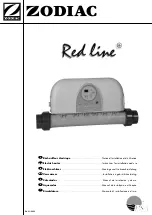
Models
SPC-21PHTTS
Page -3-
OPERATING PRECAUTIONS
This is a propane, direct-fired heater.
Propane is heavier than air. If propane leaks from a connection
or fitting, it sinks to the floor, collecting there with the
surrounding air, forming a potentially explosive mixture.
Obviously, propane leaks should be avoided, so set up the
propane supply with utmost care. Read enclosed Odor Fade
and Propane Sheet for additional information about detecting
propane leaks. Leak check new connections or reconnections
with a soap and water solution and follow all connection
instructions herein. Also, ask your propane dealer for advice on
the propane application and supply installation and ask him to
check it if there are any questions.
Direct-Fired means that all of the combustion products enter the
heated space. Even though this heater operates very close to
100 percent combustion efficiency, it still produces small
amounts of carbon monoxide. Carbon monoxide (called CO) is
toxic. We can tolerate small amounts but not a lot. CO can build
up in a heated space and failure to provide adequate ventilation
could result in death. The symptoms of inadequate ventilation
are:
headache
dizziness
burning eyes and nose
nausea
dry mouth or sore throat
So, be sure to follow advice about ventilation in these operating
instructions.
When the heater is to be operated in the presence of other
people the user is responsible for properly acquainting those
present with the safety precautions and instructions, and of
the hazards involved.
SAFETY PRECAUTIONS
1. This heater is designed for OUTDOOR USE ONLY. Even
so, make sure there is ample fresh air ventilation. Do not
use in buildings, garages, of other structures.
2. Items or material, when stored under the heater will be
subjected to radiant heat and could be seriously
damaged.
3. Maintain minimum clearances to people or normal
combustible materials: 10"- Horizontal from reflector and
ceiling, 30" from floor.
4. Always position heater on a firm level surface.
5. Do not operate this appliance in windy conditions.
Maximum allowable wind speed is 10MPH (16m/h).
6. Do not operate this appliance in temperature conditons
below 40ºF (5ºC).
7. Install this heater such that it is not directly exposed to
water spray, rain and/or dripping water.
8. Carefully supervise children and animals when heater is
in use.
9. Due to high surface temperatures, adults and children
must observe clearances to avoid burns or clothing
ignition.
10. Do not hang clothing or flammable materials either on or
near heater.
11. Do not spray aerosols near the heater during use or
shortly thereafter.
Warning: For Outdoor Use Only
12. Keep the heater away from areas where flammable liquids,
vapors or solids are stored or used.
13. Do not alter or modify the heater in any manner, and do not
operate a heater that has been modified from its original
condition.
14. Use only propane gas.
15. Use only VAPOR WITHRAWAL propane supply. If there is
any question about vapor withdrawal, ask your propane
dealer.
16. The propane cylinder must be arranged for vapor-withdraw,
in accordance with the Compress Gas Associations, Small
Propane Bottle Assembly.
17. Use only soapy water (1-part liquid dishwashing detergent
to 3-parts water) to conduct Leak Tests whenever a Propane
cylinder is connected. Bubbles indicate a leak.
18. Never use a heater if the ballast weight is not assembled
onto the base. The base must be weighted to avoid tipping.
19. Use only the regulator assembly provided with the heater.
20. Use only in accordance with local codes or in the absence
of local codes, with the National Fuel Gas Code
ANSI Z223.1.
21. Do not adjust gas regulator. If you are unsure of your
appliances gas type or pressure, call out a gas fitter or
plumber.
22. Place the control knob on "OFF" position when heater is not
in use.
23. Always disconnect the gas supply after the heater is turned
"OFF".
24. Do not move, handle or service the heater while hot or
burning.
25. Allow 45 minutes to cool down after use before attempting
to move heater.
26. Do not clean heater with combustible or corrosive cleaners.
Use warm, soapy water.
27. If wire cage is removed for servicing, it must be re-installed
before operating.
28. Inspect heater before each use, and have it inspected
annually by a qualified service person.
29. Check control compartment, burners and circulation air
passageways for free air passage. Make sure that there are
no obstructions. These are common areas for spider webs,
and other insect infestation which can present a dangerous
condition, damage the heater and render it unsafe for use.
The heater must be checked if any of the following
conditions exist:
a)
Gas smell along with predominate yellow tipping of the
burner flames.
b)
Heater does not reach temperature.
c)
Uneven burner glow.
d)
Burner makes popping noises during normal use,
other than during shutdown.




























